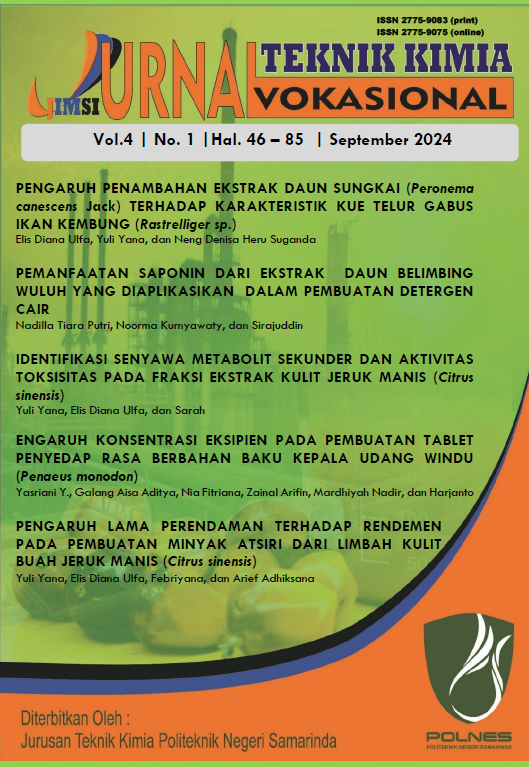IDENTIFIKASI SENYAWA METABOLIT SEKUNDER DAN AKTIVITAS TOKSISITAS PADA FRAKSI EKSTRAK KULIT JERUK MANIS (Citrus sinensis)
 Abstract views: 93
,
Abstract views: 93
,
 pdf downloads: 136
pdf downloads: 136
Abstract
Sweet citrus fruit is a favorite fruit of the people of Indonesia. Data from the Statistics Agency (BPS) recorded that orange peel waste from the production of sweet orange fruit (citrus sinensis) in 2022 in East Kalimantan reached 2,326-2,714 tons/year. Orange peel contains secondary metabolite compounds namely flavonoids, alkaloids, tannins, steroids, pectin, phenolic compounds, saponins and terpenoids. The content of active compounds owned by orange peel has been applied in the world of health, one of which is as an anti-cancer. In this study, the identification of compounds in orange peel extract was carried out by fragmenting concentrated ethanol extract of orange peel by using water solvent as a polar solvent, chloroform as a semi-polar solvent and n-hexane as a non-polar which was then carried out phytochemical tests and toxicity tests using the BSLT method. Based on this study, phytochemical tests show that orange peel extract of water fraction contains phenolic compounds and flavonoids. Chloroform fraction of alkaloid compounds and steroids. n-hexane fraction of alkaloid compounds, steroids, phenolics and flavonoids. The Lc50 value test results in water fraction extract were 381.417 ppm, chloroform fraction extract was 105.438 ppm, and n-hexane fraction extraction was 94.623 ppm. The water fraction and chloroform are classified as moderately toxic while the n-hexane fraction extract is toxic with a group of alkaloid, steroidal, phenolic and flavonoid compounds.
Keywords: : Bagasse, Biocharcoal, Briquettes, Particle Size
Copyright (c) 2024 JURNAL TEKNIK KIMIA VOKASIONAL (JIMSI)

This work is licensed under a Creative Commons Attribution-NonCommercial-ShareAlike 4.0 International License.
Copyright Transfer Statement
The copyright of this article is transferred to JIMSI and when the article is accepted for publication. the authors transfer all and all rights into and to paper including but not limited to all copyrights in the Psikostudia. The author represents and warrants that the original is the original and that he/she is the author of this paper unless the material is clearly identified as the original source, with notification of the permission of the copyright owner if necessary. The author states that he has the authority and authority to make and carry out this task.
The author states that:
- This paper has not been published in the same form elsewhere.
- This will not be submitted elsewhere for publication prior to acceptance/rejection by this Journal.
A Copyright permission is obtained for material published elsewhere and who require permission for this reproduction. Furthermore, I / We hereby transfer the unlimited publication rights of the above paper to Jurnal Teknik Kimia Vokasional. Copyright transfer includes exclusive rights to reproduce and distribute articles, including reprints, translations, photographic reproductions, microforms, electronic forms (offline, online), or other similar reproductions.
The author's mark is appropriate for and accepts responsibility for releasing this material on behalf of any and all coauthor. This Agreement shall be signed by at least one author who has obtained the consent of the co-author (s) if applicable. After the submission of this agreement is signed by the author concerned, the amendment of the author or in the order of the author listed shall not be accepted.
Rights / Terms and Conditions Saved
- The author keeps all proprietary rights in every process, procedure, or article creation described in Work.
- The author may reproduce or permit others to reproduce the work or derivative works for the author's personal use or for the use of the company, provided that the source and the Informatika Mulawarman copyright notice are indicated, the copy is not used in any way implying the Jurnal Psikostudia approval of the product or service from any company, and the copy itself is not offered for sale.
- Although authors are permitted to reuse all or part of the Works in other works, this does not include granting third-party requests to reprint, republish, or other types of reuse.
Jurnal Teknik Kimia Vokasional by http://e-journal.polnes.ac.id/index.php/jimsi licensed under a Creative Commons Attribution-ShareAlike 4.0 International License.








